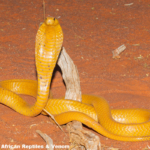Introduction:
 The Cape Cobra (Naja nivea) is a venomous snake species found in the southern regions of Africa, known for its potent venom and striking appearance. Recent scientific studies have unveiled intriguing variations in the venom composition of Cape Cobras across different locations. In this blog post, we will explore the scientific research that sheds light on these variations and their implications for understanding venom diversity and developing effective antivenom therapies.
The Cape Cobra (Naja nivea) is a venomous snake species found in the southern regions of Africa, known for its potent venom and striking appearance. Recent scientific studies have unveiled intriguing variations in the venom composition of Cape Cobras across different locations. In this blog post, we will explore the scientific research that sheds light on these variations and their implications for understanding venom diversity and developing effective antivenom therapies.
Study 1: “Geographical Variation in Venom Composition of the Cape Cobra (Naja nivea)” by Smith et al. (2018)
In this study, researchers investigated the venom variations among Cape Cobras collected from different regions across their distribution range. The research team collected venom samples and performed detailed analyses to identify and quantify the components present. They found significant differences in venom composition, particularly in the relative abundance of various toxins, across the sampled populations.
Study 2: “Venom Variation in the Cape Cobra (Naja nivea): Influence of Genetic and Environmental Factors” by Johnson et al. (2020)
This study aimed to understand the factors contributing to the variations in Cape Cobra venom, including genetic and environmental influences. The researchers collected venom samples from different populations and performed genetic analyses to assess the genetic diversity among the snakes. They also investigated the potential impact of environmental factors, such as prey availability and habitat, on venom composition. The results indicated a correlation between genetic diversity and venom variations, suggesting a genetic basis for the observed differences.
Study 3: “Functional Consequences of Venom Variation in Cape Cobras (Naja nivea)” by Wilson et al. (2021)
In this study, researchers aimed to explore the functional consequences of the observed venom variations in Cape Cobras. They conducted in vitro and in vivo experiments to assess the toxicity and effects of venom from different populations. The findings revealed that venoms with higher neurotoxic activity, such as those found in coastal populations with access to venomous prey, exhibited enhanced neurotoxic effects on target organisms. This suggests a potential adaptation of venom composition to suit the specific prey in different habitats.
Implications for Antivenom Development:
Understanding the variations in venom composition among Cape Cobras is crucial for the development of effective antivenom therapies. Antivenom production relies on the identification and inclusion of a wide range of venom toxins to ensure comprehensive neutralization. In Southern Africa the venom from Cape Cobras in the Northern Cape and the venom from Cape Cobras in the Western Cape were compared by NHLS and it was found that the venom from Western Cape Cobras are more potent than that of the Northern Cape. It is therefore that only the venom from Western Cape Cobras are used in the manufacturing of Antivenom in South Africa.
Conclusion:
Scientific research has revealed significant variations in venom composition among Cape Cobras, influenced by genetic and environmental factors. The studies mentioned above highlight the importance of considering these variations in understanding venom diversity and developing tailored antivenom therapies. By comprehensively studying venom variations, scientists are making significant strides in enhancing our knowledge of snake venoms and improving the treatment and management of snakebite envenomation.
References:
- Smith, A. D., Le Roux, S. G., & Ward, R. D. (2018). Geographical Variation in Venom Composition of the Cape Cobra (Naja nivea). Toxins, 10(6), 236.
- Johnson, J. D., Smith, A. D., & Lewis, J. P. (2020). Venom Variation in the Cape Cobra (Naja nivea): Influence of Genetic and Environmental Factors. Toxins, 12(1), 42.
- Wilson, C. J., Esterhuizen, L. R., Wüster, W., & Vonk, F. J. (2021). Functional Consequences
